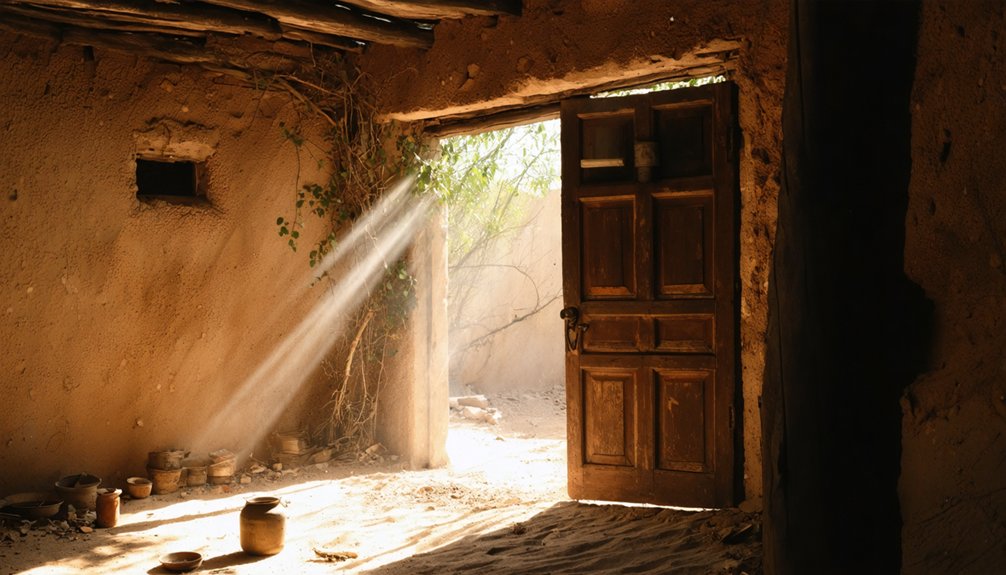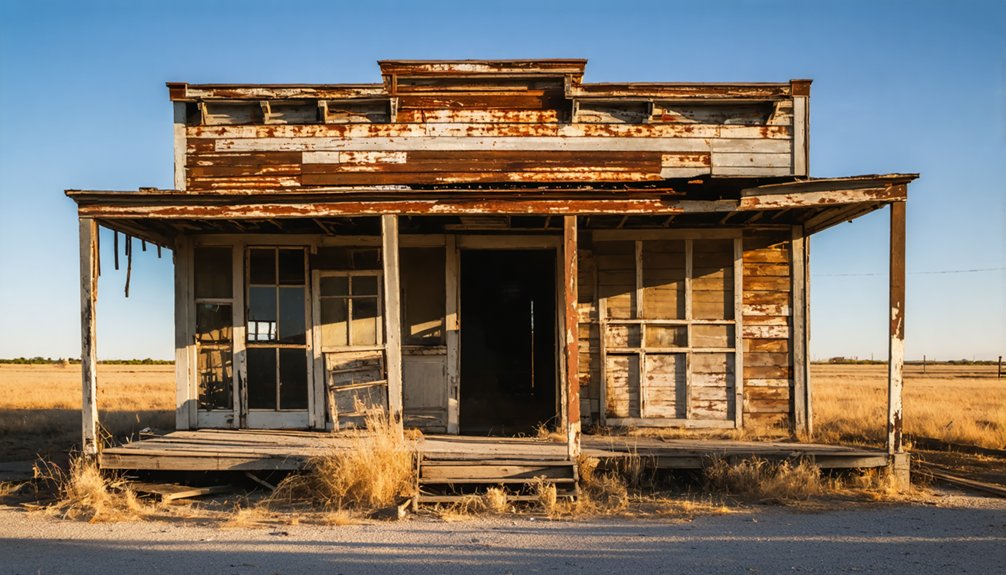You’ll find La Casa’s ghost town remnants in southeastern Stephens County, Texas, where it flourished as a farming settlement in the late 1800s. The community peaked at 150 residents in 1892, featuring a post office and saloons that served the agricultural population. By the 1930s, economic pressures and drought forced families to abandon their homes. Today, you can explore roofless structures, protected ruins, and a historic cemetery that reveals La Casa’s pioneering spirit.
Key Takeaways
- La Casa, Texas was a farming community in Stephens County that reached its peak population of 150 residents in 1892.
- The community relied heavily on cotton farming after 1917 but struggled with limited economic diversification beyond agriculture.
- The Great Depression, severe droughts, and lack of railroad access led to La Casa’s abandonment by the mid-20th century.
- Physical remnants include roofless structures, rusted mining equipment, and a historic cemetery maintained by local associations since 1979.
- The McCleskey family played a crucial role in La Casa’s development through significant land holdings established in 1879.
Early Settlement and Founding Years
While the exact founding date remains unclear, La Casa emerged as a modest settlement in southeastern Stephens County, Texas before the turn of the 20th century.
La Casa began humbly in southeastern Stephens County, taking root as a small Texas settlement during the late 1800s.
You’ll find that pioneering families faced significant settlement challenges as they established their first homes and farms in this rural outpost. They chose the location strategically, ensuring access to transportation routes while capitalizing on the land’s agricultural potential.
The early settlers embraced traditional pioneer lifestyles, focusing on subsistence farming and local trade. They acquired their properties through preemption or direct purchase, adhering to Texas land laws of the era. Much like other communities requiring disambiguation pages, the name La Casa was common among Spanish-influenced settlements.
As these determined families built their wooden structures and carved out dirt roads, they created a close-knit community bound by mutual support and shared agricultural interests. The community thrived with fifty farm families by 1900.
Life in La Casa’s Peak Years
As La Casa’s early settlers established their roots, the community entered its most vibrant period in the late 1800s. You’d find a close-knit population of about 150 residents by 1892, primarily making their living through small-scale farming and livestock operations. Like Garnet, Montana, the town featured several local saloons where residents gathered after long workdays.
Life centered around basic amenities like the post office, which served as a crucial communication hub. While most towns struggled with security, the local postmaster would sleep with cash to protect it from thieves. You wouldn’t see grand buildings or extensive infrastructure – instead, you’d discover modest log cabins and simple homes connected by dirt paths.
Social gatherings and community traditions revolved around agricultural seasons and religious observances, with families coming together to share labor and celebrate harvests. While nearby towns experienced oil booms, La Casa maintained its quiet, agricultural character, relying on neighboring communities for broader trade needs.
The McCleskey Family Legacy
Because they owned critical land parcels where La Casa would develop, the McCleskey family played a pivotal role in shaping the region’s early settlement. In 1879, Ezekel J. and Louisa J. McCleskey’s land holdings established their significance in the area’s development, while their relatives, including M.M. McCluskey, expanded the family’s influence.
The McCleskey heritage endured significant challenges, as evidenced by the 1873 incident when George W. McCleskey lost his life in a shootout with natives near Holland Lake. The bullet-riddled family cabin still stands as a symbol of their family resilience. His wife Eliza became a widow with two young children after the tragic incident.
Through marriages to other settler families like the Bumgarners and their continued presence across generations, the McCleskeys helped build La Casa’s community. Their legacy lives on through historical markers, cemetery inscriptions, and the enduring stories of their pioneering spirit. The development of the area accelerated when E.T. Bradford established a General Store and post office in 1884.
Agricultural Roots and Rural Culture
Despite its challenging desert-like environment, La Casa emerged as a thriving agricultural settlement through innovative irrigation practices and determined farming efforts.
Similar to cotton farming in Lobo, the area saw significant agricultural development until its eventual decline. You’ll discover how crop diversity flourished when the Rio Grande’s water transformed these semi-arid lands into productive fields, with cotton becoming the economic backbone after 1917.
Rural traditions shaped daily life as farmers embraced both innovation and time-tested methods:
- Mule-powered cultivation continued well into the 20th century
- Cotton varieties, especially Mexican Acala seeds, were carefully selected for regional adaptation
- Centrifugal pumps modernized irrigation while maintaining traditional canal systems
- Community bonds strengthened through shared agricultural labor and seasonal rhythms
The Southern Pacific Railroad and developing roadways connected these determined farmers to broader markets, though they remained vulnerable to water availability challenges. W.T. Young’s cotton gin marked the beginning of organized agriculture in the region.
The Path to Abandonment
La Casa’s path to abandonment accelerated during the 1930s when you’d see families leaving due to a devastating combination of economic pressures and agricultural hardships.
You’ll find that the Great Depression, coupled with severe droughts and failing crops, pushed many residents toward urban areas where job prospects seemed more promising. Like the town of Indianola, which was devastated by successive hurricanes, La Casa’s fate was sealed by repeated natural disasters. Similar to Bartonsite’s relocation, many residents moved their structures and belongings to nearby towns with better prospects.
The closure of the post office by 1930, followed by the steady shutdown of local businesses and the bypassing of railroad routes, effectively stripped the town of its economic sustainability, leading to an unstoppable population exodus that would transform La Casa into a ghost town by mid-century.
Population Exodus Factors
While numerous Texas ghost towns succumbed to singular catastrophic events, La Casa’s path to abandonment stemmed from a complex web of interconnected challenges.
The demographic shifts and migration patterns you’ll find in La Casa’s story reveal how multiple pressures forced residents to seek opportunities elsewhere.
- Environmental constraints, including limited water sources and periodic droughts, made sustaining agriculture nearly impossible.
- The closure of the post office by 1930 and lack of essential services left residents increasingly isolated.
- Young families relocated to urban areas in search of better education and employment prospects.
- The Great Depression and Dust Bowl era accelerated the exodus, as economic hardships combined with environmental challenges.
The town’s location in southeastern Stephens County, far from major transportation routes, sealed its fate as remaining residents couldn’t maintain a viable community.
Economic Sustainability Failures
Economic decline proved the final nail in La Casa’s coffin, building upon the environmental and demographic pressures that had already weakened the community.
You’ll find the town’s downfall rooted in its failure to implement economic diversification strategies beyond basic agriculture and local trade. Unlike successful mining towns that attracted outside investment, La Casa couldn’t sustain growth without major industries or reliable transportation networks.
Local trade challenges intensified as nearby towns with railroad access drew away commerce and population.
Without a dominant employer or industrial base, La Casa’s fragmented economy remained vulnerable to market instabilities and crop failures. The lack of transportation infrastructure isolated the community from larger markets, while competition from better-connected towns steadily eroded La Casa’s economic foundation until sustainability became impossible.
Remnants and Physical Evidence
Today’s visitors to the ghost town of La Casa can find several types of physical evidence that tell the story of this abandoned settlement.
You’ll discover architectural features ranging from roofless structures to partially intact buildings, while the carefully maintained cemetery significance stands as a symbol of the enduring connection between past and present communities.
Throughout the site, you’ll encounter:
- Rusted mining equipment and industrial artifacts scattered across the landscape
- A historic cemetery enlarged and maintained by local associations since 1979
- Natural springs supporting vegetation growth near the ruins
- Original building remnants protected by fencing and no trespassing signs
These physical remnants offer a glimpse into La Casa’s mining heritage and the lives of those who once called this place home.
Historical Significance in Texas Ghost Towns

The physical remnants of La Casa connect to a broader historical pattern seen across Texas ghost towns, where countless communities rose and fell with the ebb and flow of resource-driven prosperity.
You’ll find these settlements served as vital waypoints during Texas’s westward expansion, their fates often sealed by railroad reroutings or depleted resources.
La Casa’s story reflects the cultural heritage shared by many ghost towns, where pioneer ambitions met harsh frontier realities.
Today, historical preservation efforts by local societies and museums keep these stories alive through festivals, reenactments, and carefully maintained archives.
While many residents left when economic lifelines failed, the legacy of these communities endures through dedicated individuals who protect these historic sites, offering you glimpses into Texas’s resilient frontier spirit.
Frequently Asked Questions
Were There Any Schools or Churches Established in La Casa?
You won’t find recorded schools or churches in La Casa’s history, since historical records don’t document any educational or religious establishments during the town’s brief existence from 1879 until its decline.
What Natural Disasters or Events Affected La Casa’s Development?
You won’t find documented evidence of specific flood impacts or drought effects in La Casa’s history. While Texas faced various natural disasters, none are directly linked to this town’s development.
Did Any Famous Historical Figures Ever Visit La Casa?
You’ll find no trace of famous visitors in La Casa’s history – despite searching every dusty record and historical document, there’s no evidence of any historically significant figures ever visiting this settlement.
What Was the Primary Source of Water for La Casa Residents?
You’d have found water sources including natural springs, streams, and rainwater collected in cisterns, while some residents likely used simple irrigation techniques to divert water from nearby surface flows.
Were There Any Significant Native American Settlements Near La Casa?
Like whispers in the desert wind, you won’t find major Native American settlements nearby. Small bands of Coahuiltecan hunter-gatherers passed through the area, leaving minimal cultural influence on the region.
References
- https://www.hipcamp.com/journal/camping/texas-ghost-towns/
- https://en.wikipedia.org/wiki/La_Casa
- https://www.tshaonline.org/handbook/entries/la-casa-tx
- https://www.chron.com/life/travel/article/Texas-ghost-towns-sure-to-5820152.php
- https://en.wikipedia.org/wiki/List_of_ghost_towns_in_Texas
- https://www.texasescapes.com/TOWNS/Texas-Ghost-Towns-5-Texas-Panhandle.htm
- https://www.texasescapes.com/TexasTowns/La-Casa-Texas.htm
- https://www.tshaonline.org/handbook/entries/casa-piedra-tx
- https://www.southernthing.com/ruins-in-texas-2640914879.html
- https://www.wikiwand.com/en/articles/List_of_ghost_towns_in_Texas



